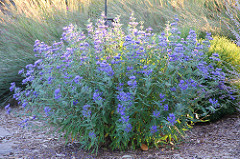Even if the dog hasn’t bitten and the bee hasn’t stung (as the song goes), it’s always nice to think on your favorite things. Here are a few of our favorites.
Stephanie’s Favorite Flower:
 Trumpet vine / Campsis radica ns:
Trumpet vine / Campsis radica ns:
Right now, I am loving my Trumpet Vine because it is covered with tubular, orange flowers that attract hummingbirds, bees, butterflies and pollinators of all kinds. Campsis radicans is a very vigorous, low-water use vine. Due to the limitations of the trellis my vine grows on, I have to cut this vine back HARD early each spring. This does not discourage it at all, as it is well established and has intentions of taking over the world. If you’re thinking of planting Trumpet Vine, remember this rhyme (which applies to all types of vines, actually): the first year it sleeps; the second year it creeps; the third year it leaps. You may be tempted to plant more than one vine, but you really should just be patient! I love this plant and it’s flowers, but it’s growth potential and vigor should not be underestimated!
Chesney’s Favorite Flower:
Blue Mist Spirea / Caryopteris x clandonedisis 
Blue Mist Spirea has many characteristics that make it a great option for any yard. It blooms later in the year to add some color while most plants are already starting to go dormant, the multitude of purple-blue blooms are unique and stand out in the fall, the flowers attract bees and other pollinators, it has a nice mounded shape, is not bothered by pests like deer or rabbits, and it is very low maintenance and xeric. Blue Mist Spirea is happiest in full sun with low water but will tolerate some shade. This flowering shrub grows to be about 3 to 4 feet tall and wide each season. The only maintenance it really needs is to be pruned down to about 5 inches in late winter/ early spring before the growing season takes off.
Chesney’s Favorite Tool:
 My favorite tool is yet another tie… I use a lot of tools during the day and have a few that are what I would consider a necessity and some that I would consider more of a luxury. One of those necessary tools is a good shovel. I have found that when planting perennials and smaller shrubs I prefer a good edging shovel. It is generally a little shorter and the blade is thinner than a regular shovel. I find that it digs the perfect size hole and is easier to control than a regular spade.
My favorite tool is yet another tie… I use a lot of tools during the day and have a few that are what I would consider a necessity and some that I would consider more of a luxury. One of those necessary tools is a good shovel. I have found that when planting perennials and smaller shrubs I prefer a good edging shovel. It is generally a little shorter and the blade is thinner than a regular shovel. I find that it digs the perfect size hole and is easier to control than a regular spade.
The tool that I have found that is definitely a luxury is a bulb dibber. You can plant bulbs using a shovel or trowel but a bulb dibber makes the job easier. The one that I use (and totally love) is a hand held tool with a big stainless-steel point at the end and it makes the perfect little hole for a bulb (such as a daffodil, tulip or crocus) to be nice and happy!



